|
The diamond is
the oldest item one can ever own. Diamonds are pure
carbon - it is one of the earth’s most common elements.
It is a simple material, found in graphite pencils and
fireplace soot. Diamonds were formed, and crystallized
eons ago under incredible heat and pressure deep in the
earth. During the Earth’s growing phase millions of
years ago, great volcanic forces pushed the "blue earth"
containing diamonds to the surface where they were
scattered along rivers and into the oceans. In 1870, in
South Africa a diamond was found in the earth far from a
river source, and the practice of dry-digging for
diamonds was born. These were the beginnings of modern
mining.
The Greek word "Adamas"
means unconquerable and indestructible. This is the
origin of the word “Diamond”. It is one of the most
indestructible natural formations known to man.
Many early
cultures and many countries used diamonds for their own
reasons, each with their own meanings. Ancient man used
the raw diamond to create tools and carvings. For
example, when tribes in Africa and the Middle East
expanded their trade with one another, these rare stones
became a mode of exchange, the world's first hard
currency. The symbols and representations of the diamond
are expansive and individual. For some it meant the key
to magic, healing, protection and even poisoning; to
others - it’s wealth, prosperity, status, and
everlasting love. It was even said that in ancient
Greece and Rome Cupids' arrows were tipped with diamonds
which had an effect equal to nothing. They have been the
strength, power and symbols of Kings and Queens, the
ruin of kingdoms, and the teardrops of forgotten Gods.

Today one of the
most common uses of the diamond from a sociological
aspect is in the engagement and wedding rings. Even in
the 2nd Century in Rome, the ring was used in the
ceremony before the Emperor and his blessing. The custom
was then continued and mostly Christianized by the 4th
century by St. Augustine. Byzantine wedding rings are
thick gold bands with round or oval bezels depicting the
couple face to face, or receiving Christ's blessing of
their eternal union. Today the diamond ring, commits a
man and a woman to each other with the expression of
strength, purity, brilliance and the indestructible bond
of love
Below is a
brief look at the history and timeline of the diamond:
3.3 billion years ago
Almost 200 km
below the earth’s surface carbon began to evolve under
extreme pressure and heat, the beginnings of the
formation of the most valued commodity on earth, - the
Diamond.
1200 – 1400AD
Diamonds begin to
appear in Europe as accent decoration in other forms of
Jewelry. King Louis IX of France (1226–70), bestows
rarity to diamonds and establishes intrinsic value on
them. Within 100 years diamonds appeared in royal
jewelry of both men and women, then among the greater
European aristocracy. The earliest diamond-cutting
industry is believed to have been in Venice, a trade
capital, starting sometime after 1330.
1477
The Archduke
Maximillian of Austria “proposes” to his wife to be Mary
of Burgundy with a Diamond Ring, a symbol of his
betrothal. Hence the first recorded engagement ring. It
was worn on the 3rd finger of the right hand, in order
to be against a specific vein that goes directly to the
heart.
1550
Antwerp Belgium,
the most important diamond center of the period, where a
Diamond-cutters' Guild was soon to be established.
1600 - 1750
The Diamond was
the first and foremost symbol of ultimate wealth and
prosperity in Europe. India was the only know source of
diamonds. Brazil was soon to follow.
1860
A discovery of
diamonds near Hopetown, south of Kimberley in South
Africa, gives birth to the modern diamond industry. The
1870s and 1880s in the Northern Cape saw a mad rush to
the newly discovered diamond fields.
1905
The world's
largest gem quality diamond, the Cullinan, was found in
South Africa. Uncut, it weighed 3025 carats. It was
presented to King Edward VII for his 66th birthday.
1939
The criteria for
Diamonds established. The standards and the 4 C’s, Cut,
Colour, Carat, and Clarity are published.
1967 - 2000
Botswana becomes
the largest producer of diamonds by value in the world.
The Centenary, found in 1986, was polished from a 599
carat gem. The rough diamond was cut into various
stones, the largest of which bears the name Centenary
and, at 273 carats, is the Largest Modern Cut, Top
Color, Flawless Diamond in the world.
Today diamonds
are found in all five continents of the world, but not
to the same extent in each. The oldest diamond deposits
were found in Asia and have been known and worked from
the earliest times. Diamonds have been known longer in
India than in any other country in the world. There is a
comparatively small number of diamonds in existence,
which either on account of their size, beauty, or
historic and ancient associations, possess a special
interest. All the older diamonds famous for their large
size and enormous value, which are known by special
names, come from India. In recent times, diamonds of
remarkable size have been discovered in Brazil and South
Africa. The value of such rare stones is naturally
enormous and they usually find a place among the crown
jewels of different countries, rarely entering into the
possession of private individual except in the case of a
few wealthy collectors.

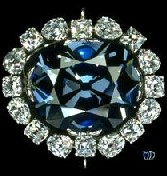
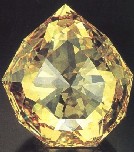
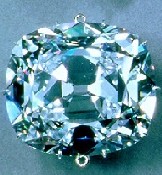
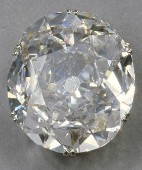
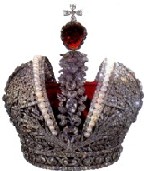
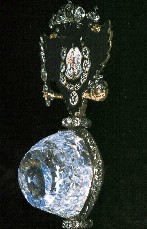
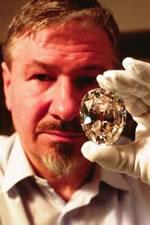
The large Indian
diamonds are all thought to be of ancient discovery.
However, the majority of them do not have records dating
to very early times. Probably, the largest among them
all is the "Great Mughal" seen in the treasury of Mughal
Emperor Aurangzeb in 1666, by Tavernier, who both drew
and described the stone in detail. The diamond, weighed
280 carats, was in the form of a very high and round
rosette and was of good quality. The original stone is
supposed to have been found in the mines of Golconda in
South India between 1630 and 1650 and is supposed to
have weighed 787 carats. The subsequent history of the
Great Mughal is a complete blank. It is variously
supposed to have been lost or destroyed, to be in
existence under another name, such as the "Orloff"
diamond. Others believe it be in the possession of the
crown jewels of the Shah of Persia.
Another large
diamond of the same weight has been described in the
memoirs of Babur, the founder of the Mughal dynasty.
According to this account the diamond has long been
famous in India, and had formed the spoils of war of
many Indian princes, finally passing into the possession
of Babur in 1556. Nadir Shah appropriated the Babur's
diamond after invading India in the year 1739. He
renamed it as “Koh-i-noor”. It passed into the
hands of Ranjit Singh in the year 1813, and after the
British annexation of Punjab, became the property the
East India Company and presented to Queen Victoria in
the year 1850 and was re-cut to a size of 106 carats.
The Koh-i-noor, today a part of the British Crown
jewels, is now a stone of considerable beauty, slightly
grayish in color, with a brilliant luster, but it is a
question whether re-cutting it was money well invested,
since the gem, though a much more brilliant and
attractive jewel, has ceased to be an object of
interest to the mineralogist or antiquarian; for, in
its present form - an oval stone, weighing one hundred
and six carats - there is no suggestion as to its
natural shape, while all interest attached to it by
association is now lost with the loss of its identity
Among the Russian
Crown jewels, the "Orloff" is the largest of all
diamonds and may be found in the Diamond Treasury of
Russia in Moscow. Tavernier's description of the Orloff
diamond is very similar to two other gems- The Great
Mughal and the Koh-i-noor:
300 Carats when
found, slightly bluish green in colour, and
exceptionally pure in clarity. Cut: Mogul-cut rose,
there
are so many historical episodes involving the Orloff.
First, it may have been set at one time as the diamond
eye of Vishnu's idol (one of the Hindu Gods) in the
innermost sanctuary temple in Sriangam, before being
stolen in the 1700s by a French deserter. However, the
deserter just dug one eye from its socket, because he
was terror-stricken at the thought of retribution, so he
couldn't take the other. He went to Madras, and sold the
stone quickly to an English sea-captain for 2,000
pounds.
The time passed,
the stone arrived at Amsterdam where the Russian count
Grigori Orloff, an ex-lover of Empress Catherine the
Great was residing. He heard about rumors of the stone,
and he bought the diamond for 90,000 pounds and took it
back to Russia for Catherine's favor. The stone has been
called the Orloff since then. Catherine received
his gift and had it mounted in the Imperial Sceptre. She
gave a marble palace to Grigori in exchange for the
Orloff. However, Grigori couldn't get Catherine's love.
Grigori Orloff passed away at the nadir of
disappointment in 1783.
In 1812 the
Russians, fearing that Napoleon with his Grand Army was
about to enter Moscow, hid the Orloff in a priest's
tomb. Napoleon supposedly discovered the Orloff's
location and went to claim it. However, as a solider of
the Army was about to touch the Orloff, a priest's ghost
appeared and pronounced a terrible curse upon the Army.
Napoleon scampered away without the Orloff.
Among the Persian
Crown jewels are two large diamonds, the "Darya-e-Noor"
(Sea of Light) that weighs 186 carats, and the other
"Taj-e-Mah" (Crown of the Moon), which weights 146
carats. Both are of purest clarity and are cut as
rosettes and valued at one million pound sterling.
The "Regent"
or "Pitt" is a large diamond forms a part of the
French Crown jewels. It had its origins in India in 1701
and was purchased by Pitt the Governor of Madras. The
Regent of France acquired it in 1717 for 80,000 pounds
and it was re-cut from 410 to 136 carats. In the
valuation of the French Crown jewels in 1791 this
diamond was stated to be worth 480, 000 pounds.
The
"Florentine" is a large diamond now forms a part of
the imperial treasury at Vienna. This diamond is
distinctly yellow in color, and weighs 139 carats. It is
beautifully clear and shows a fine fire. After
frequently changing hands it came to the possession of
Duke of Tuscany, who brought it to Vienna, its final
resting place
The “Blue
Hope” - 45.52 Carats, the ironically named Hope
diamond (named for its purchaser, Henry Thomas Hope) may
have had a long and illustrious history before it became
associated with a run of bad luck for its owners.
It is thought to
be a part of the famous Blue Tavernier Diamond, brought
to Europe from India in l642. The Blue was purchased by
King Louis XIV who had it cut to 67.50 carats from 112
carats to bring out its brilliance. The diamond was
stolen during the French Revolution, and a smaller
diamond of similar color was sold in 1830 to Hope, an
English banker. After inheriting the diamond, Hope's son
lost his fortune.
It was eventually
acquired by an American widow, Mrs. Edward McLean, whose
family then suffered a series of catastrophes: her only
child was accidentally killed, the family broke up, Mrs.
McLean lost her money, and then committed suicide. When
Harry Winston, the New York diamond merchant, bought the
stone in 1949, many clients refused to uch the stone. It
is now on display at the Smithosonian Institute in
Washington.
The best known
yellow diamond “The Tiffany” was found in the De
Beers mine at Kimberly in 1878 and weighed 287.42
carats. The following year it was bought by Charles
Lewis Tiffany, the famous Fifth Avenue Jeweler, and was
cut in Paris as a cushion-shaped brilliant with 90
facets, cut weight 128.54 carats. The Tiffany Yellow is
one of the largest yellow diamonds in existence. Eighty
years were to pass after its discovery before the
beautiful orange-yellow diamond was set in a piece of
jewelry. The Tiffany Yellow diamond was mounted in a
necklace and worn for the first time as a personal
ornament at the Tiffany Ball in Newport, Rhode Island in
1957. The honor of this first wearing went to the Ball's
chairwoman, Mrs. Sheldon Whitehouse.. In 1971 the
Tiffany returned to South Africa for the exhibition
which marked the centennial celebration of the Kimberley
Mine. After an absence of forty years from London,
Tiffany's re-opened their branch in Old Bond Street in
1986 and displayed the diamond to herald their return.
The sole hiatus in the otherwise uneventful history of
the Tiffany has centred on reported attempts to sell the
diamond which was valued at $12,000,000 at the end of
1983.
The 128.54-carat
Tiffany Yellow remains on permanent display on the
ground floor of the Tiffany & Co. store in New York
City.
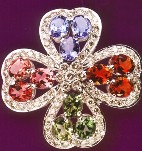
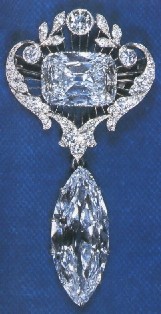
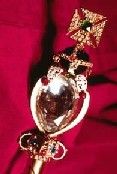
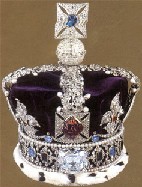
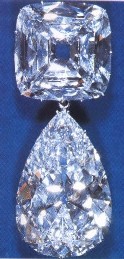
The "Dresden
Green" diamond preserved in the "Green Vaults" of
Dresden is the most famous representative of the stones
of this color. It has a fine apple-green color,
perfectly transparent, almond shaped in form and weighs
about 40 carats. Since 1748 it has been the property of
the Saxon Crown. It is said August the Strong paid 60000
thalers to acquire it.
The "Kimberly
diamond" was originally a 490-carat rough diamond
found in the Kimberly mines of South Africa. It was cut
into its present size of 70 carats in the year 1921 and
again into an emerald shape in the year 1951. It was
widely exhibited until a private collector in Texas
purchased it in the year 1971.
Harry Winston
first purchased the "Niarchos" diamond as a part of 8.4
million dollars deal. It is a blue-white flawless
diamond, weighing about 128 carats. It was sold 1957 to
Stavros Niarchos, the Greek shipping Magnate who gave
the diamond its present name.
The
"Oppenheimer" diamond purchased by Harry Winston was
presented to the Smithsonian Institution in memory of
the late Sir Ernest Oppenheimer of De Beers Consolidated
Mines. This almost perfect yellow crystal, weighing
approximately 253 carats was found in the Dutoitspan
Mine, Kimberly, South Africa in 1964
The "Star of
Sierra Leone" when it was first found weight
approximately half-a-pound, and was the third largest
diamond ever found. The 969-carat diamond was
subsequently cut into seventeen exquisite individual
diamonds, six of which are now set in the Star of Sierra
Leone Brooch.
The "Kahn
Canary" diamond, which weighs 4.25 carats, is a
unique find because of its flawless condition and a
pleasing natural triangular yellow shape and has
remained in its uncut form. The diamond was first
discovered by George Stepp of Carthage Arkansas in
crater of Diamonds State Park and later sold to Kahn
Jewelers.
The "Hortensia"
is a peach colored diamond was named after Hortense de
Beauharnais, the stepdaughter of Napoleon Bonaparte. The
Hortensia had been part of the French Crown Jewels since
Louis XIV bought it. At present, Hortensia is on display
in the Louvre, Paris.
The "Idol's
eye", weighing 70.2 carats is flattened pear shaped
diamond that is believed to have once set in the eye of
an idol before it was stolen. Legend has it that it was
given as a ransom for Princess Rasheedah by the King of
Kashmir to the Sultan of Turkey who had abducted her.
The "Jubilee
Diamond" weighing about 245 carats the most
perfectly cut of all large diamonds. Its facets are so
exact that it can be balanced on the culet point, which
is less than two millimeters across. At present this
majestic diamond is on display at the DeBeers Diamond
Pavilion in Johannesburg.
The "Great
Chrysanthemum" weighing nearly 104 carats is a pear
shaped diamond cut from 198.28 carat brown rough found
in South Africa in 1963. Julius Cohen, a New York City
dealer, bought the rough and had it cut to reveal the
diamond's rich golden-brown, chrysanthemum-like color.
In 1971, the diamond was exhibited at the Kimberly
Centenary Exhibition in South Africa. The diamond also
was shown in the Diamonds-International Academy
Collection at the Diamond Pavilion in Johannesburg in
1965. Recently, Julius Cohen sold the Great
Chrysanthemum to an undisclosed foreign buyer.
The “Cullinan”
diamonds or the “Star of Africa” as it is popularly
known, discovered in 1905, are all parts of the nine
large diamonds and form the property of the British
Imperial Crown jewels. The largest weighs 530 carts. The
Cullinan II adorns the center-front of Imperial State
Crown of Britain and can be viewed with the other crown
jewels in the Tower of London. | 